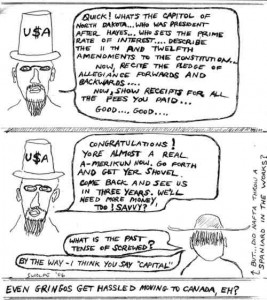Column by Hal Walter
Rural Life – June 2006 – Colorado Central Magazine
DESPITE THE ILLOGICAL RAMBLINGS of letter-writing cranks, there is yet another good reason to not build a wall or fence along the border with Mexico.
What if some of our residents want to get out?
That’s exactly what some friends — we’ll call them Len and Denise to protect their privacy — are doing. This past winter developers began building a reported 10,000-acre subdivision behind the couple’s small acreage in the Wet Mountains. They have lived there in their small home for quite some time, though they have been known to take frequent lengthy vacations south of the border. Nevertheless, they have been there longer than I have lived in Custer County, and that would be 22 years this very month. They raised two children there, not to mention numerous bountiful high-altitude gardens, and even a little hell.
The way I heard it, the day the subdivision surveyors arrived, Len just happened to be making somewhat of a racket by plinking away with a rifle on his backyard target range. That activity is less than conducive to marketing lots in a high-end trophy-home subdivision. Not long after that, Len and Denise were presented with an offer that would make them fairly wealthy in Mexico.
“They wanted to get rid of us pig farmers,” Len said.
Their new 5-acre home site is well above the high-tide mark somewhere on the Sea of Cortez. They plan to build an open-air house in the manner of the residents of a sleepy fishing village there, and operate a guide service for visiting gringos.
And what will become of their former home?
“They’re going to bulldoze it . . . it and all the work we put into this place,” Len said.
The funny thing is, I never knew Len and Denise to keep pigs.
*********
Speaking of livestock, Dallas, the owner of the local “7 Pines National Chicken Refuge,” delivers fresh eggs to my house just about every week. On a recent delivery he mentioned that he had just bought several batches of chicks that he expects to be laying eggs this summer, but worried whether he would be able to stay in business in the future. It turns out that Big Brother is pulling on his overalls and heading for the farm.
In a strange and absurd blend of 1984 meets Animal Farm, the USDA in April announced the implementation of the National Animal Identification System, which is aimed at requiring all farmers, or anyone owning one or more livestock animals, to register their premises and critters. The program would include farmed fish, llamas and alpacas, cattle and bison, deer and elk, equines, goats, poultry, sheep, and swine.
The stated purpose of the program, according to the USDA, is to protect us from Mad Cow disease, bird flu, bioterrorism and other machinations of the industry of fear. The unstated design, according to some owners of small farms, is to help big agribusiness put them out of business.
The program is starting out as voluntary, but the goal is to make it mandatory. Wisconsin has already passed a law mandating farmers to register. Thus far 252,636 premises have been registered nationwide. Registration will be used to develop a National Animal Identification Database, available to the animal health and public health Gestapo.
Some animals, like cattle, could be outfitted with radio frequency identification devices so they may be tracked electronically. Others may be tagged in other ways, including — if you can believe it — retinal scans and DNA testing.
George Orwell, are you out there?
[Unidentfied cows in the field.]
Registered animal owners also would be required to identify animals any time these animals leave their premises. For instance, students participating in 4-H projects would have to comply. Livestock owners who take llamas to shows or horses to trail rides would need to notify the authorities. Even entrants in the World Championship Pack-Burro Race would need to inform authorities they are taking their burros to the race, and that these animals “commingled” with other burros.
While the program is not yet mandatory in all states, for now the USDA is counting on market pressures to force farmers and ranchers into compliance. For example a small cattle rancher may need to comply in order to sell animals at a sale barn or a feedlot, or to ship animals across state lines. In fact, the Colorado Cattlemen’s Association is taking up the topic of compliance at its annual meeting in Pueblo in June with an “Animal ID Myth Busters Forum.”
The fact of the matter is this program really does nothing to prevent or detect disease before there is a problem — there is no testing or screening. Its sole purpose is to provide a system to track problems such as Mad Cow back to the source within 48 hours. The real aim is to help big farm interests increase foreign markets.
Critics say the program will increase costs to small livestock owners, invade the privacy of farmers and ranchers, violate constitutional rights, and impede individual freedoms.
One rancher friend of mine noted that when Hoof and Mouth Disease struck in England authorities went from farm to farm destroying entire herds that farmers literally spent generations building. Hoof and Mouth is not necessarily fatal to livestock and does not even render meat inedible. Humans reportedly can carry the disease but are not susceptible to it. The threat was purely from a marketing perspective.
Nevertheless, when it was all said and done, the herds were destroyed and some farmers had committed suicide in the wake of their losses.
Registration of farms and animals would make it easier for authorities to carry out such hysteria here in the United States. As my rancher friend says, “Why don’t they just tag the farmer while they’re at it? How far are we away from that?”
*********
Sometimes it feels a little like a drug deal when I buy meat products, meeting suppliers in parking lots, fields and other out-of-the-way places to make the transaction. Once I waited in the dark at a warehouse near the railroad tracks in Pueblo to buy a Thanksgiving turkey from one of the local food co-ops.
Some people wonder why I don’t just buy my food at the grocery store like everyone else. In my efforts to support local agriculture and buy more nutritious foods, I am willing to go to such lengths to get grass-fed beef, pasture-roaming pork, fresh eggs, organic vegetables, and perhaps the occasional free-range fowl flying just a little under the industrial food complex radar.
For my extra effort I get meats with real flavor, texture and color the likes of which usually cannot be found in a grocery store, including those of the “health food” variety. I trust my dealers to supply me with safe and nutritious foods. I cannot say the same for the big agribusiness, with its factory approach to farming.
When the government finally does require small producers to register their premises and tag every animal they raise, some of them will probably be forced out of business by the costs of registration and compliance. In a nation built on the backs of independent family farmers, it will be a sad day indeed.
Hal Walter raises free-range microchip-free burros in the Wet Mountains near Westcliffe. For more information about the National Animal Identification System, check out www.usda.gov/nais/ and www.stopanimalid.org.


